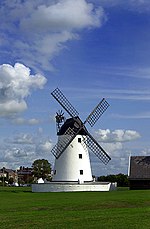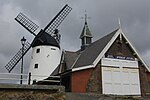Lytham (Station Road) railway station
The original Lytham railway station was the Lytham terminus of a branch of the Preston and Wyre Joint Railway from Kirkham in Lancashire, England. It opened, along with the branch, on 16 February 1846; the road it was located in became known as Station Road. It was built in a Renaissance style from Longridge stone. A branch was also built to the dock at Lytham Pool. In 1863, the Blackpool and Lytham Railway opened a separate line to its own station in Ballam Road, Lytham. By 1874, both lines were owned jointly by the Lancashire and Yorkshire Railway and the London and North Western Railway. Ballam Road station was rebuilt as a through station and a connecting line was built to join the other line east of Lytham. The original station in Station Road was then closed to passengers, but continued to be used as a goods station until 1963.A fire station now occupies the site.
Excerpt from the Wikipedia article Lytham (Station Road) railway station (License: CC BY-SA 3.0, Authors).Lytham (Station Road) railway station
Haven Road, Borough of Fylde
Geographical coordinates (GPS) Address Website Nearby Places Show on map
Geographical coordinates (GPS)
| Latitude | Longitude |
|---|---|
| N 53.7384 ° | E -2.9566 ° |
Address
Lytham Fire Station
Haven Road
FY8 5DJ Borough of Fylde
England, United Kingdom
Open on Google Maps









